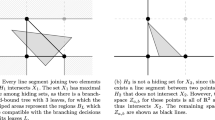Abstract
We develop anexact algorithm for selecting partial scan flip-flops to break all feedback cycles. We also permit the option of not breaking self-loops. The key ideas that allow us to solve this complex problemexactly for large, practical instances are—an MFVS-preserving graph transformation, a partitioning scheme used in the branch and bound procedure, and pruning techniques based on an integer linear programming formulation of the MFVS problem. We have obtained optimum solutions for all ISCAS'89 benchmark circuits and several production VLSI circuits within reasonable computation time. For example, the optimal number of scan flip-flops required to eliminate all cycles except self-loops in the circuit s38417 is 374. An optimal solution was obtained in 32 CPU seconds on a SUN Sparc 2 workstation.
Similar content being viewed by others
References
E. Trischler, “Incomplete Scan Path with an Automatic Test Generation Methodology,” inProceedings of the International Test Conference, pp. 153–162, 1980.
M. Abramovici, J.J. Kulikowski, and R.K. Roy, “The Best Flip-Flops to Scan,” inProceedings of the International Test Conference, pp. 166–173, 1991.
V.D. Agrawal, K.T. Cheng, D.D. Johnson, and T. Lin, “Designing Circuits with Partial Scan,”IEEE Design and Test of Computers, Vol. 5, pp. 8–15, April 1988.
H.-K.T. Ma, S. Devadas, A.R. Newton, and A. Sangiovanni-Vincentelli, “An Incomplete Scan Design Approach to Test Generation for Sequential Machines,” inProceedings of the International Test Conference, pp. 730–734, 1988.
V. Chickermane and J.H. Patel, “A Fault Oriented Partial Scan Design Approach,” inProceedings of the International Conference on Computer-Aided Design, pp. 400–403, November 1991.
K.T. Cheng and V.D. Agrawal, “A Partial Scan Method for Sequential Circuits with Feedback,”IEEE Transactions on Computers, Vol. 39, pp. 544–548, April 1990.
D.H. Lee and S.M. Reddy, “On-Determining Scan Flip-Flops in Partial-Scan Designs,” inProceedings of the International Conference on Computer-Aided Design, pp. 322–325, November 1990.
S. Park and S.B. Akers, “A Graph Theoretic Approach to Partial Scan Design by K-Cycle Elimination,” inProceedings of the International Test Conference, pp. 303–311, 1992.
A. Kunzmann and H.J. Wunderlich, “An Analytical Approach to the Partial Scan Problem,”Journal of Electronic Testing: Theory and Applications, Vol. 1, pp. 163–174, 1990.
R. Gupta, R. Gupta, and M.A. Breuer, “The BALLAST Methodology for Structured Partial Scan Design,”IEEE Transactions on Computers, Vol. C-39, pp. 538–544, April 1990.
H.B. Min and W.A. Rogers, “A Test Methodology for Finite State Machines using Partial Scan Design,”Journal of Electronic Testing: Theory and Applications, Vol. 3, pp. 127–137, May 1992.
D.H. Younger, “Minimum Feedback Vertex Sets for Directed Graphs,”IEEE Transactions on Circuit Theory, Vol. 10, pp. 238–245, June 1963.
A. Lempel and I. Cederbaum, “Minimum Feedback Arc and Vertex Sets for Directed Graphs,”IEEE Transactions on Circuit Theory, Vol. 13, pp. 399–403, December 1966.
G.W. Smith and R.B. Walford, “The Identification of Minimum Feedback Vertex Set of a Directed Graph,”IEEE Transactions on Circuits and Systems, Vol. 22, pp. 9–14, January 1975.
P. Asher and S. Malik, “Implicit Computation of Minimum-cost Feedback Vertex Sets for Partial Scan and other Applications,” inProceedings of the 31st ACM/IEEE Design Automation Conference, June 1994.
E.L. Lloyd, M.L. Soffa, and C.C. Wang, “On Locating Minimum Feedback Vertex Sets,”Journal of Computer and System Sciences, Vol. 37, pp. 293–311, 1988.
H. Levy, and L. Low, “A Contraction Algorithm for Finding Small Cycle Cutsets,”Journal of Algorithm, Vol. 9, pp. 470–493, 1988.
E.L. Lloyd, Personal communication.
H.H.S. Gundlach and K.D. Muller-Glasser, “On Automatic Test Point Insertion in Sequential Circuits,” inProceedings of the International Test Conference, pp. 1072–1079, September 1990.
C.H. Papadimitriou and K. Steiglitz,Combinatorial Optimization Algorithms and Complexity, Englewood Cliffs, New Jersey: Prentice Hall, 1982.
A.W. Tucker, “On Directed Graphs and Integer Programs,” Presentation at theSymposium on Combinatorial Problems, Princeton University, 1960.
S. Bhawmik, C.J. Lin, K.T. Cheng, and V.D. Agrawal, “Pascant: A Partial Scan and Test Generation System,” inCustom Integrated Circuits Conference, pp. 17.3.1–17.3.4, 1991.
S.T. Chakradhar and S. Dey, “Resynthesis and Retiming for Optimum Partial Scan,” inProceedings of the 31st ACM/IEEE Design Automation Conference, pp. 87–93, June 1994.
S.T. Chakradhar, A. Balakrishnan and V.D. Agrawal, “An Exact Algorithm for Selecting Partial Scan Flip Flops,” inProceedings of 31st Design Automation Conference, pp. 81–86, June 1994.
Author information
Authors and Affiliations
Rights and permissions
About this article
Cite this article
Chakradhar, S.T., Balakrishnan, A. & Agrawal, V.D. An exact algorithm for selecting partial scan flip-flops. J Electron Test 7, 83–93 (1995). https://doi.org/10.1007/BF00993316
Received:
Revised:
Issue Date:
DOI: https://doi.org/10.1007/BF00993316




